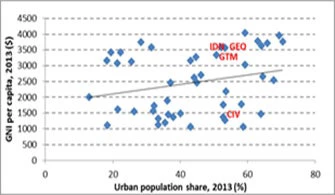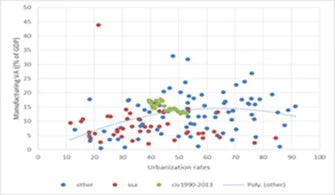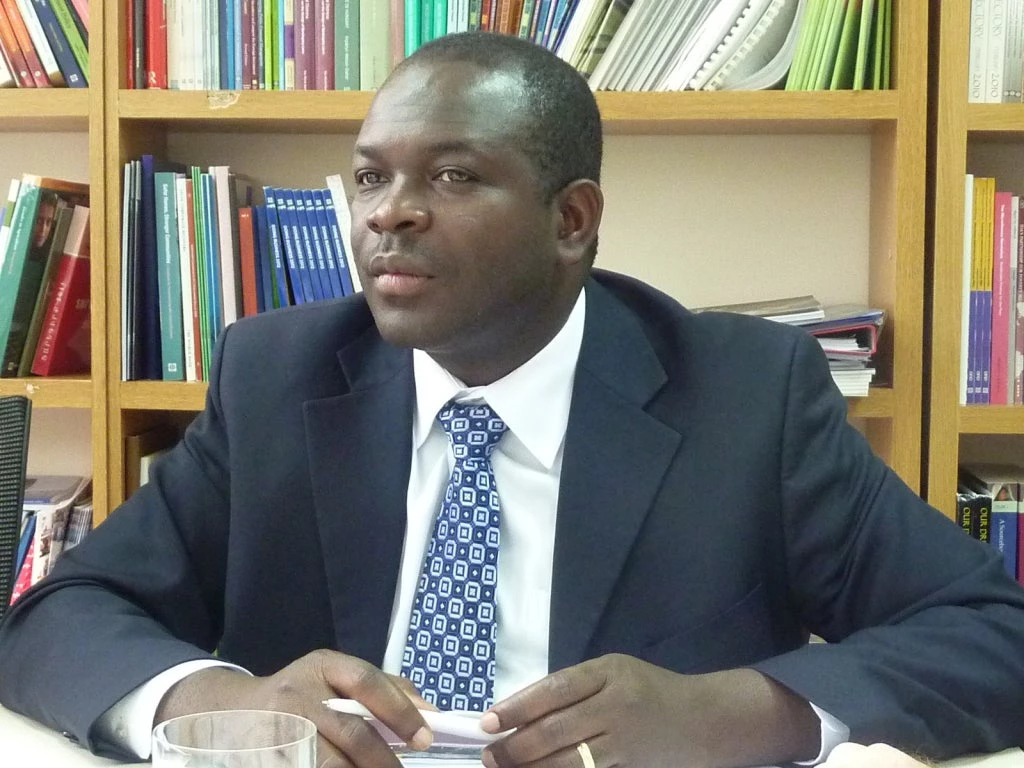Urbanization is not just about development of a single city within a country. In fact, a country’s cities can be treated as a portfolio of assets, each differentiated by characteristics that include size, location, and density of settlement (WDR 2009), each with its own role to play in the country’s economic development and poverty reduction. Small cities, for example, facilitate internal scale economies, such as hosting large firms to transform local agricultural products. Medium-sized cities facilitate localization economies by enabling linkages between firms operating in the same industry, and large cities create urbanization economies through a diverse economic base nurturing innovation.
A recent report, Cote d’Ivoire Urbanization Review: Diversified Urbanization, uses the case of Cote d’Ivoire to propose a typology of cities to support the country’s economic transformation: global connectors, regional connectors and domestic connectors. Each of these types of cities require a differentiated approach to planning, connectivity, greening and financing of the infrastructure needs.
Abidjan, San Pédro, and Yamoussoukro are Côte d’Ivoire’s natural global connectors. The Greater Abidjan area dominates with 20% of the population, 80% of formal employment, and 90% of formal enterprises. It is an advanced urban area facing similar challenges of other metropolitan areas around the world. The port of San Pédro, built from scratch under the first development plan, is the main export gateway for agricultural products, and was planned to be connected by rail to the mineral heart of the West (Man and its surroundings). Yamoussoukro has been the capital since the 1980s, although national public administration is still in Abidjan. The city has one of the most reputable polytechnic engineering schools in francophone Africa, offering the potential to build bridges to technology companies if information and communications technology (ICT) infrastructure is scaled up to global standards.
The regional connectors of Côte d’Ivoire are connected to the West African region through five corridors. The northern corridor connects Abidjan with Ouagadougou through a road and rail link that passes through Bouaké (the country’s second-largest city), Korhogo (the capital of the Northern region with nearly 200,000 inhabitants), and Ferkessédougou (a secondary city of 75,000 inhabitants). Eastward, Côte d’Ivoire is connected to Lagos, Nigeria, via a road running through Aboisso and Noe on the Ivorian side and through three capital cities in West Africa (Accra in Ghana, Lomé in Togo, and Cotonou in Benin). Another eastward connection to Ghana (via Kumassi and Tamale) runs through Adzope, Abengourou, and Bondoukou. Abidjan is connected to Nzerekore in Guinea via a road through Yamoussoukro, Daloa, and Man, each of which has more than 150,000 inhabitants and is in a region rich in agriculture, minerals, or tourism. Another westward connection to Monrovia in Liberia goes through Grand Lahou, Sassandra, San Pédro, and Tabou along the Gulf of Guinea. If we consider the threshold of 100,000 inhabitants, the following secondary cities along the three regional corridors are the main Regional Connectors: Adzope and Abengourou (East corridor), Bouaké and Korhogo (North corridor), and Daloa and Man (West corridor).
Côte d’Ivoire’s small cities and market towns could be anchors, generating scale economies for agribusiness. While southwest regions strongly contribute to the production and export of cash crops, savanna areas can help scale up food and cereal production to supply urban centers domestically and regionally. In the long term, with the movement of the cocoa belt from eastern and central regions to the south (with an eye on the port of San Pédro), climate change and international economic conditions might once more shift the heart of these cash-crop production areas. Given increasing regional disparities in Côte d’Ivoire, good connections between the agricultural hinterlands of secondary cities with strategic regional capital cities may help smallholders to modernize into agribusiness chains.
Well-managed urbanization can accelerate Côte d’Ivoire’s ascendance to a middle income country. With an urban population share of 50% in 2014, Cote d’Ivoire’s Gross National Income (GNI) per capita is at $1,380 (figure 1). Georgia, Guatemala and Indonesia, three countries located in three different continents and with an urban population share close to that of Côte d’Ivoire, have GNI per capita of $3,570, $3,340 and $3,580 respectively. Such a large gap in GNI per capita means that the underlining economic drivers of urbanization are not being fully harnessed in Côte d’Ivoire. Better managing urbanization can nurture activities that generate higher returns in economic growth and job creation through the expansion of the manufacturing sector (figure 2).
To achieve diversified urbanization, Ivorian policy makers need to act urgently along four dimensions:
A recent report, Cote d’Ivoire Urbanization Review: Diversified Urbanization, uses the case of Cote d’Ivoire to propose a typology of cities to support the country’s economic transformation: global connectors, regional connectors and domestic connectors. Each of these types of cities require a differentiated approach to planning, connectivity, greening and financing of the infrastructure needs.
Abidjan, San Pédro, and Yamoussoukro are Côte d’Ivoire’s natural global connectors. The Greater Abidjan area dominates with 20% of the population, 80% of formal employment, and 90% of formal enterprises. It is an advanced urban area facing similar challenges of other metropolitan areas around the world. The port of San Pédro, built from scratch under the first development plan, is the main export gateway for agricultural products, and was planned to be connected by rail to the mineral heart of the West (Man and its surroundings). Yamoussoukro has been the capital since the 1980s, although national public administration is still in Abidjan. The city has one of the most reputable polytechnic engineering schools in francophone Africa, offering the potential to build bridges to technology companies if information and communications technology (ICT) infrastructure is scaled up to global standards.
The regional connectors of Côte d’Ivoire are connected to the West African region through five corridors. The northern corridor connects Abidjan with Ouagadougou through a road and rail link that passes through Bouaké (the country’s second-largest city), Korhogo (the capital of the Northern region with nearly 200,000 inhabitants), and Ferkessédougou (a secondary city of 75,000 inhabitants). Eastward, Côte d’Ivoire is connected to Lagos, Nigeria, via a road running through Aboisso and Noe on the Ivorian side and through three capital cities in West Africa (Accra in Ghana, Lomé in Togo, and Cotonou in Benin). Another eastward connection to Ghana (via Kumassi and Tamale) runs through Adzope, Abengourou, and Bondoukou. Abidjan is connected to Nzerekore in Guinea via a road through Yamoussoukro, Daloa, and Man, each of which has more than 150,000 inhabitants and is in a region rich in agriculture, minerals, or tourism. Another westward connection to Monrovia in Liberia goes through Grand Lahou, Sassandra, San Pédro, and Tabou along the Gulf of Guinea. If we consider the threshold of 100,000 inhabitants, the following secondary cities along the three regional corridors are the main Regional Connectors: Adzope and Abengourou (East corridor), Bouaké and Korhogo (North corridor), and Daloa and Man (West corridor).
Côte d’Ivoire’s small cities and market towns could be anchors, generating scale economies for agribusiness. While southwest regions strongly contribute to the production and export of cash crops, savanna areas can help scale up food and cereal production to supply urban centers domestically and regionally. In the long term, with the movement of the cocoa belt from eastern and central regions to the south (with an eye on the port of San Pédro), climate change and international economic conditions might once more shift the heart of these cash-crop production areas. Given increasing regional disparities in Côte d’Ivoire, good connections between the agricultural hinterlands of secondary cities with strategic regional capital cities may help smallholders to modernize into agribusiness chains.
Well-managed urbanization can accelerate Côte d’Ivoire’s ascendance to a middle income country. With an urban population share of 50% in 2014, Cote d’Ivoire’s Gross National Income (GNI) per capita is at $1,380 (figure 1). Georgia, Guatemala and Indonesia, three countries located in three different continents and with an urban population share close to that of Côte d’Ivoire, have GNI per capita of $3,570, $3,340 and $3,580 respectively. Such a large gap in GNI per capita means that the underlining economic drivers of urbanization are not being fully harnessed in Côte d’Ivoire. Better managing urbanization can nurture activities that generate higher returns in economic growth and job creation through the expansion of the manufacturing sector (figure 2).
| Figure 1 The Ivorian economy is underperforming urbanization... |
Figure 2: … although manufacturing is better correlated with urbanization |
 |
 |
|
Source: WDI; World Bank staff calculations
Note: CIV: Côte d’Ivoire; GEO: Georgia; GTM: Guatemala; IDN: Indonesia
|
Source: WDI; World Bank staff calculations
Note: CIV: Côte d’Ivoire; SSA: Sub-Saharan Africa; Other: All other countries excluding SSA countries
|
To achieve diversified urbanization, Ivorian policy makers need to act urgently along four dimensions:
- Planning—charting a course for cities by setting the terms of urbanization, especially policies for using urban land, enabling housing markets, and expanding basic infrastructure and public services.
- Connecting—making a city’s markets accessible (labor, goods, and services) to other cities and to other neighborhoods in the city, as well as to export markets.
- Greening—enhancing livability of cities by reducing pollution and emissions and conserving scarce environmental and financial resources.
- Financing—finding sources for large capital outlays needed to provide infrastructure and services as cities grow and urbanization picks up speed.


Join the Conversation